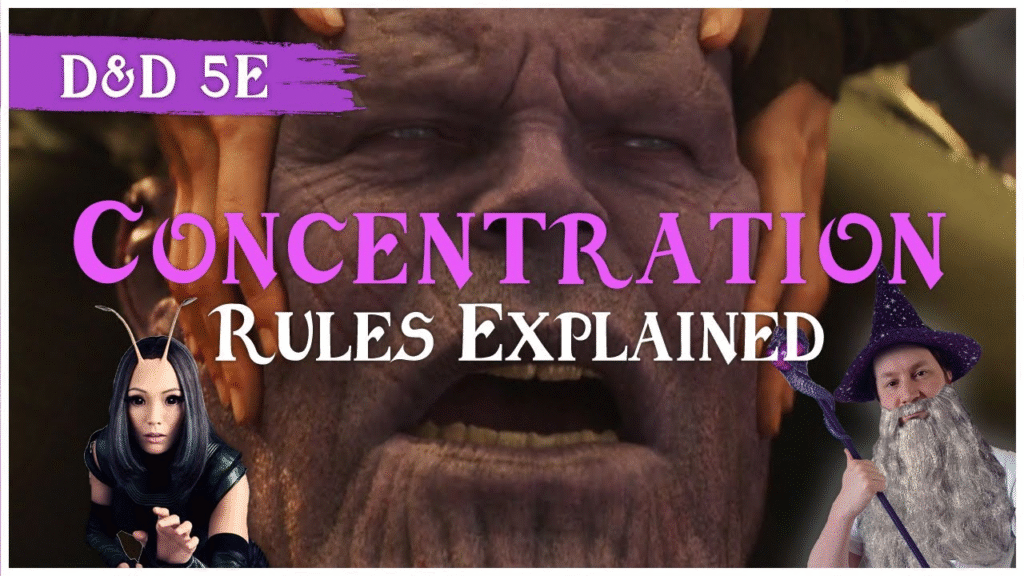In Dungeons & Dragons 5th Edition (5e), concentration is one of the most important mechanics to understand for both players and Dungeon Masters (DMs). Whether you’re a spellcaster maintaining a crucial buff or a DM enforcing the rules, knowing how concentration works can make or break an encounter.
This comprehensive guide will break down everything about concentration 5e—from the core rules to advanced tactics for keeping spells active under pressure.
What Is Concentration in D&D 5e?
In D&D 5e, concentration represents a caster’s mental effort to maintain a spell’s magical effect over time. Many spells require concentration, meaning you can only sustain one such spell at a time.
This mechanic is designed to balance the power of ongoing magical effects and to force meaningful tactical decisions during combat.
The Rules of Concentration: A Breakdown
Understanding how concentration works starts with the official rules from the Player’s Handbook (PHB, p. 203). Here are the key points:

You Can Only Concentrate on One Spell at a Time
If you begin casting a new concentration spell while already concentrating on another, the first spell automatically ends.
Example: A wizard concentrating on Fly starts casting Hold Person. As soon as Hold Person is cast, Fly ends.
When You Must Make a Concentration Check
Whenever you take damage while concentrating, you must succeed on a Constitution saving throw to maintain the spell.
- DC (Difficulty Class): The DC is 10 or half the damage you take, whichever is higher.
- Rolling the Save: Roll 1d20 + your Constitution saving throw modifier.
Example: A sorcerer concentrating on Haste takes 18 damage from an enemy’s attack. The DC for the concentration check is 10 (since half of 18 is 9 and 10 is higher).
Other Situations That Break Concentration
Besides taking damage, concentration can also end if:
- You are incapacitated or killed.
- You are forced to make a saving throw due to environmental effects (like being in a storm on a ship).
- You choose to stop concentrating (no action required).
Actions That Do NOT Break Concentration
Players often ask whether certain actions interfere with concentration. Here are clarifications:
✅ Casting Non-Concentration Spells: You can freely cast other spells that don’t require concentration.
✅ Attacking, Moving, or Using Bonus Actions: None of these inherently break concentration.
Why Concentration Matters: Tactical Implications
The concentration mechanic is a key balancing feature in D&D 5e. Without it, spellcasters could stack multiple powerful effects like Bless, Haste, and Invisibility, dominating every encounter.
For players:
- You must weigh which spell is most critical to maintain at any given moment.
For DMs:
- Concentration provides a built-in vulnerability for spellcasters, which monsters and NPCs can exploit intelligently.
Tips for Maintaining Concentration
Losing concentration at the wrong moment can turn the tide of battle. Here are some practical strategies to help you keep your spells active:

1. Boost Your Constitution Saving Throws
Your Constitution modifier directly impacts your concentration saves. Classes like druids and wizards can consider feats like War Caster or Resilient (Constitution) to improve their odds.
- War Caster Feat: Grants advantage on concentration saves and allows casting with hands full.
- Resilient (Constitution): Gives +1 Constitution and proficiency in Constitution saving throws.
2. Avoid Damage Where Possible
Stay behind cover, out of melee range, or use spells like Mirror Image and Shield to minimize incoming attacks. Remember: no damage means no concentration saves.
3. Keep Healing Options Ready
Having a party member ready to heal you quickly after you take damage can prevent incapacitation, which would otherwise end your concentration.
4. Communicate with Your Party
If you’re concentrating on a key spell like Haste or Bless, let your allies know. They can help protect you from attacks and focus their efforts on keeping you alive.
Common Concentration Spells in D&D 5e
To fully understand how concentration impacts gameplay, let’s look at some of the most frequently used concentration spells:
| Spell | Level | Duration | Effect |
|---|---|---|---|
| Bless | 1st | Concentration, up to 1 min | Boosts allies’ attack rolls and saving throws |
| Haste | 3rd | Concentration, up to 1 min | Grants extra actions and speed |
| Invisibility | 2nd | Concentration, up to 1 hr | Turns a creature invisible |
| Hold Person | 2nd | Concentration, up to 1 min | Paralyzes humanoids |
| Fly | 3rd | Concentration, up to 10 min | Grants flying speed to creatures |
Knowing which of these spells to prioritize in a fight can be the difference between victory and defeat.
Concentration for DMs: Adjudicating Fairly
As a DM, enforcing concentration rules fairly helps maintain the game’s balance. Here’s how:
- 💡 Remind players when concentration saves are needed.
- ⚔️ Have enemies use intelligent tactics to pressure casters.
- 📖 Encourage new players to read up on the mechanic between sessions.
You can also flavor concentration as part of your narrative: describe how a spellcaster’s focus wavers as arrows fly past or as they grit their teeth to maintain control of powerful magic.
Frequently Asked Questions About Concentration 5e
Can you cast two concentration spells at once?
No. Casting a second concentration spell immediately ends the first one.
Does being stunned or paralyzed break concentration?
Yes. Both conditions cause you to become incapacitated, which ends concentration automatically.
Do area-of-effect spells like Fireball require concentration?
No. Instantaneous spells like Fireball don’t require concentration because their effects happen immediately.
Conclusion: Mastering the Art of Concentration
Understanding and mastering concentration in D&D 5e is crucial for every spellcaster and Dungeon Master. It balances powerful magic, creates tense moments in combat, and rewards smart tactics. Whether you’re maintaining Haste on your fighter or trying to keep Hold Person active against a dangerous enemy, knowing the rules and strategies around concentration can take your game to the next level.
- glenechogolf – General blog page for related strategy and focus articles.


